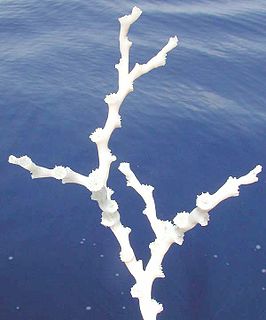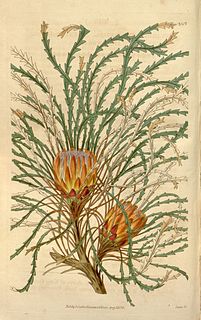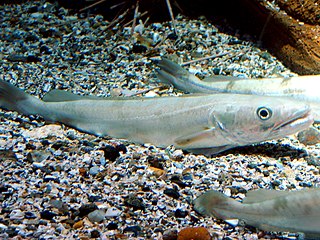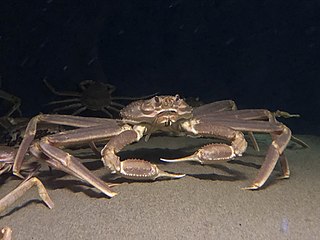The term hake refers to fish in the:

The black sea bass is a species of marine ray-finned fish, a sea bass from the subfamily Serraninae which is part of the family Serranidae, which also includes the groupers and anthias. It is found in the western Atlantic Ocean where it is an important species for commercial and recreational fisheries.

The Atlantic white-sided dolphin is a distinctively coloured dolphin found in the cool to temperate waters of the North Atlantic Ocean.

The porbeagle is a species of mackerel shark in the family Lamnidae, distributed widely in the cold and temperate marine waters of the North Atlantic and Southern Hemisphere. In the North Pacific, its ecological equivalent is the closely related salmon shark (L. ditropis). It typically reaches 2.5 m (8.2 ft) in length and a weight of 135 kg (298 lb); North Atlantic sharks grow larger than Southern Hemisphere sharks and differ in coloration and aspects of life history. Gray above and white below, the porbeagle has a very stout midsection that tapers towards the long, pointed snout and the narrow base of the tail. It has large pectoral and first dorsal fins, tiny pelvic, second dorsal, and anal fins, and a crescent-shaped caudal fin. The most distinctive features of this species are its three-cusped teeth, the white blotch at the aft base of its first dorsal fin, and the two pairs of lateral keels on its tail.

Lophelia pertusa, the only species in the genus Lophelia, is a cold-water coral which grows in the deep waters throughout the North Atlantic ocean, as well as parts of the Caribbean Sea and Alboran Sea. L. pertusa reefs are home to a diverse community, however the species is extremely slow growing and may be harmed by destructive fishing practices, or oil exploration and extraction.

The chain catshark or chain dogfish is a small, reticulated catshark that is biofluorescent. The species is common in the Northwest Atlantic, Gulf of Mexico and Caribbean. It is harmless and rarely encountered by humans. It has very similar reproductive traits to the small-spotted catshark.

The North Pacific hake, Pacific hake, Pacific whiting, or jack salmon is a ray-finned fish in the genus Merluccius, found in the northeast Pacific Ocean from northern Vancouver Island to the northern part of the Gulf of California. It is a silver-gray fish with black speckling, growing to a length of 90 cm (3 ft). It is a migratory offshore fish and undergoes a daily vertical migration from the surface to the seabed at depths down to about 1,000 m (3,300 ft). It is the object of an important commercial fishery off the West Coast of the United States, and annual quotas are used to prevent overfishing.

The red hake or squirrel hake, Urophycis chuss, is a species of phycid hake. It is found in the Atlantic Ocean at depths between 10 and 500 m. It grows to about 30 in (75 cm) and 7 lb (3.2 kg). Red hake are edible, and are sought out by recreational fisherman as a gamefish.

The Atlantic halibut is a flatfish of the family Pleuronectidae. They are demersal fish living on or near sand, gravel or clay bottoms at depths of between 50 and 2,000 m. The halibut is among the largest teleost (bony) fish in the world, and is a threatened species due to a slow rate of growth and overfishing. Halibut are strong swimmers and are able to migrate long distances. Halibut size is not age-specific, but rather tends to follow a cycle related to halibut abundance.

The silver hake, Atlantic hake, or New England hake is a merluccid hake of the genus Merluccius, found in the northwest Atlantic Ocean. It is highly predatory and typically feeds on fish and crustaceans.

The yellowspotted catshark is a rare catshark of the family Scyliorhinidae. It is found in the southeast Atlantic, from Lüderitz, Namibia to central Natal, South Africa, between latitudes 0° and 37° S. It can grow up to a length of about 1.22 metres. The reproduction of this catshark is oviparous.

Banksia tenuis is a species of shrub that is endemic to the southwest of Western Australia. It has pinnatifid, serrated or smooth-edges leaves, golden brown and cream-coloured flowers in heads of about fifty-five and glabrous, egg-shaped follicles.
Chimaera monstrosa, also known as the rabbit fish or rat fish, is a northeast Atlantic and Mediterranean species of cartilaginous fish in the family Chimaeridae. The rabbit fish is known for its characteristically large head and small, tapering body. With large eyes, nostrils, and tooth plates, the head gives them a rabbit-like appearance, hence the nickname “Rabbit fish”. They can grow to 1.5 metres (5 ft) and live for up to 30 years.

Merluccius merluccius, the European hake, is a merluccid hake of the genus Merluccius. Other vernacular names include Cornish salmon and herring hake. It is a predatory species which was often netted alongside one of its favoured prey, the Atlantic herring, thus the latter common name. It is found in the eastern Atlantic from the Norway and Iceland south to Mauritania and into the Mediterranean Sea. It is an important species in European fisheries and is heavily exploited with some populations thought to be being fished unsustainably.

Chionoecetes opilio, is a species of snow crab, also known as opilio crab or opies, is a predominantly epifaunal crustacean native to shelf depths in the northwest Atlantic Ocean and north Pacific Ocean. It is a well-known commercial species of Chionoecetes, often caught with traps or by trawling. Seven species are in the genus Chionoecetes, all of which bear the name "snow crab". C. opilio is related to C. bairdi, commonly known as the tanner crab, and other crab species found in the cold, northern oceans.

Illex coindetii, commonly known as the southern shortfin squid or broadtail shortfin squid, is a species of neritic squids in the family Ommastrephidae. They are found in the Mediterranean Sea and on both sides of the north Atlantic Ocean.

Illex illecebrosus, commonly known as the northern shortfin squid, is a species of neritic squids in the family Ommastrephidae. Squids of the genus Illex account for 65% of the world’s cephalopod captures. Illex is formed by four taxa distributed throughout the Atlantic Ocean, whose identification and phylogenetic relationships based on morphological characters remain controversial.They are found in the northwest Atlantic Ocean, from off the coast of eastern North America to Greenland, Iceland, and west of Ireland and the United Kingdom. They are a highly migratory and short-lived species, with lifespans of less than a year. They are commercially important and are fished extensively, mostly for the Canadian and Japanese markets. Northern shortfin squid is a migratory species of squid with a distribution ranging from Florida Straits to Newfoundland in the Northwest Atlantic Ocean. The species is native to Canada, Greenland, Iceland and United States. The species has an average lifespan between 1–1.5 years in which most live less than a year. The location of the fishery of the squid is mainly in Mid-Atlantic Bight from between summer and fall.

Urophycis is a genus of phycid hakes.

Urophycis regia is a species of phycid hake.
Merluccius australis, the Southern hake, is a species of fish from the family Merlucciidae, the true hakes. It is found in the southern Pacific and Atlantic Oceans with two disjunct populations, one around southern South America and the other in the waters around New Zealand.

















